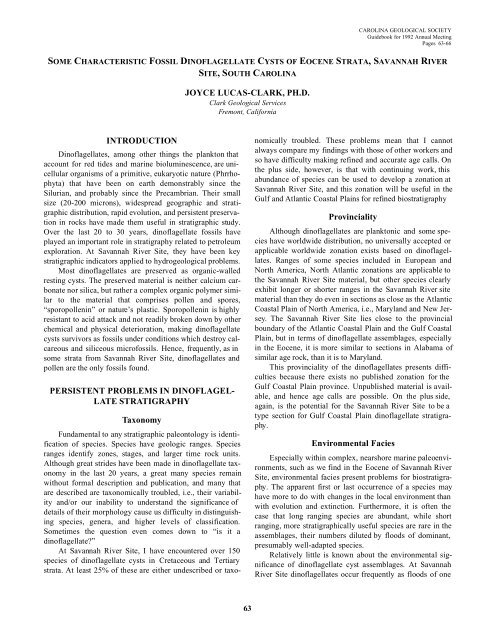Download Guidebook as .pdf (1.8 Mb) - Carolina Geological Society
Download Guidebook as .pdf (1.8 Mb) - Carolina Geological Society
Download Guidebook as .pdf (1.8 Mb) - Carolina Geological Society
Create successful ePaper yourself
Turn your PDF publications into a flip-book with our unique Google optimized e-Paper software.
CAROLINA GEOLOGICAL SOCIETY<br />
<strong>Guidebook</strong> for 1992 Annual Meeting<br />
Pages 63-66<br />
SOME CHARACTERISTIC FOSSIL DINOFLAGELLATE CYSTS OF EOCENE STRATA, SAVANNAH RIVER<br />
SITE, SOUTH CAROLINA<br />
JOYCE LUCAS-CLARK, PH.D.<br />
Clark <strong>Geological</strong> Services<br />
Fremont, California<br />
INTRODUCTION<br />
Dinoflagellates, among other things the plankton that<br />
account for red tides and marine bioluminescence, are unicellular<br />
organisms of a primitive, eukaryotic nature (Phrrhophyta)<br />
that have been on earth demonstrably since the<br />
Silurian, and probably since the Precambrian. Their small<br />
size (20-200 microns), widespread geographic and stratigraphic<br />
distribution, rapid evolution, and persistent preservation<br />
in rocks have made them useful in stratigraphic study.<br />
Over the l<strong>as</strong>t 20 to 30 years, dinoflagellate fossils have<br />
played an important role in stratigraphy related to petroleum<br />
exploration. At Savannah River Site, they have been key<br />
stratigraphic indicators applied to hydrogeological problems.<br />
Most dinoflagellates are preserved <strong>as</strong> organic-walled<br />
resting cysts. The preserved material is neither calcium carbonate<br />
nor silica, but rather a complex organic polymer similar<br />
to the material that comprises pollen and spores,<br />
“sporopollenin” or nature’s pl<strong>as</strong>tic. Sporopollenin is highly<br />
resistant to acid attack and not readily broken down by other<br />
chemical and physical deterioration, making dinoflagellate<br />
cysts survivors <strong>as</strong> fossils under conditions which destroy calcareous<br />
and siliceous microfossils. Hence, frequently, <strong>as</strong> in<br />
some strata from Savannah River Site, dinoflagellates and<br />
pollen are the only fossils found.<br />
PERSISTENT PROBLEMS IN DINOFLAGEL-<br />
LATE STRATIGRAPHY<br />
Taxonomy<br />
Fundamental to any stratigraphic paleontology is identification<br />
of species. Species have geologic ranges. Species<br />
ranges identify zones, stages, and larger time rock units.<br />
Although great strides have been made in dinoflagellate taxonomy<br />
in the l<strong>as</strong>t 20 years, a great many species remain<br />
without formal description and publication, and many that<br />
are described are taxonomically troubled, i.e., their variability<br />
and/or our inability to understand the significance of<br />
details of their morphology cause us difficulty in distinguishing<br />
species, genera, and higher levels of cl<strong>as</strong>sification.<br />
Sometimes the question even comes down to “is it a<br />
dinoflagellate”<br />
At Savannah River Site, I have encountered over 150<br />
species of dinoflagellate cysts in Cretaceous and Tertiary<br />
strata. At le<strong>as</strong>t 25% of these are either undescribed or taxonomically<br />
troubled. These problems mean that I cannot<br />
always compare my findings with those of other workers and<br />
so have difficulty making refined and accurate age calls. On<br />
the plus side, however, is that with continuing work, this<br />
abundance of species can be used to develop a zonation at<br />
Savannah River Site, and this zonation will be useful in the<br />
Gulf and Atlantic Co<strong>as</strong>tal Plains for refined biostratigraphy<br />
Provinciality<br />
Although dinoflagellates are planktonic and some species<br />
have worldwide distribution, no universally accepted or<br />
applicable worldwide zonation exists b<strong>as</strong>ed on dinoflagellates.<br />
Ranges of some species included in European and<br />
North America, North Atlantic zonations are applicable to<br />
the Savannah River Site material, but other species clearly<br />
exhibit longer or shorter ranges in the Savannah River site<br />
material than they do even in sections <strong>as</strong> close <strong>as</strong> the Atlantic<br />
Co<strong>as</strong>tal Plain of North America, i.e., Maryland and New Jersey.<br />
The Savannah River Site lies close to the provincial<br />
boundary of the Atlantic Co<strong>as</strong>tal Plain and the Gulf Co<strong>as</strong>tal<br />
Plain, but in terms of dinoflagellate <strong>as</strong>semblages, especially<br />
in the Eocene, it is more similar to sections in Alabama of<br />
similar age rock, than it is to Maryland.<br />
This provinciality of the dinoflagellates presents difficulties<br />
because there exists no published zonation for the<br />
Gulf Co<strong>as</strong>tal Plain province. Unpublished material is available,<br />
and hence age calls are possible. On the plus side,<br />
again, is the potential for the Savannah River Site to be a<br />
type section for Gulf Co<strong>as</strong>tal Plain dinoflagellate stratigraphy.<br />
Environmental Facies<br />
Especially within complex, nearshore marine paleoenvironments,<br />
such <strong>as</strong> we find in the Eocene of Savannah River<br />
Site, environmental facies present problems for biostratigraphy.<br />
The apparent first or l<strong>as</strong>t occurrence of a species may<br />
have more to do with changes in the local environment than<br />
with evolution and extinction. Furthermore, it is often the<br />
c<strong>as</strong>e that long ranging species are abundant, while short<br />
ranging, more stratigraphically useful species are rare in the<br />
<strong>as</strong>semblages, their numbers diluted by floods of dominant,<br />
presumably well-adapted species.<br />
Relatively little is known about the environmental significance<br />
of dinoflagellate cyst <strong>as</strong>semblages. At Savannah<br />
River Site dinoflagellates occur frequently <strong>as</strong> floods of one<br />
63













